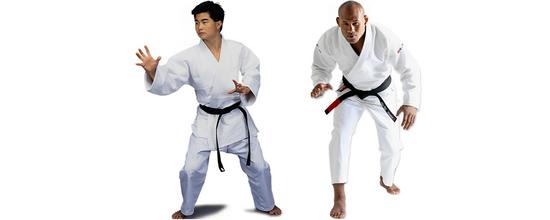Table of content
1. Brief History of BJJ and JJJ
Brazilian Jiu-Jitsu (BJJ) originated from Kodokan judo. In 1882, Kano Jigoro founded Kodokan judo. By 1909, jiu-jitsu finally came to Brazil. Brazilian Jiu-Jitsu was invented to help smaller fighters incapacitate larger opponents. The first BJJ international competition was hosted by Oswaldo Ales and organized in 1996. In Abu Dhabi, the No-Gi BJJ tournament was founded by Sheik Tahnoon Bin Zayed Al Nahyan in 1998. Over the past 20 years, BJJ has grown in popularity.
Japanese Jiu-Jitsu was used as a form of hand-to-hand combat by samurai around 2,000 years ago. However, nobody actually knows where jiu-jitsu specifically originated and who actually invented it, although there are different legends about its origins. Mitsuyo Maeda invented modern Japanese Jiu-Jitsu to teach Japanese soldiers how to fight unarmed during the war. Over time, Japanese Jiu-Jitsu evolved by incorporating new skills and techniques. JJJ included the use of weapons, including clubs and knives. However, JJJ became more well known throughout Japan in 1989. Modern JJJ includes traditional striking, grappling, and ground fighting.
2. Reasons For Why Japanese Jiu-Jitsu Isn't Used as Much As BJJ
Japanese Jiu-Jitsu is considered the oldest martial art to teach grappling interchangeably. But Japanese Jiu-Jitsu has become less popular in modern times. Though Japanese Jiu-Jitsu is similar to Brazilian Jiu-Jitsu, it is not as popular in Mixed Martial Art (MMA). Here are reasons why that is the case:
2.1 Illegal Techniques
When fighting, both combatants want to win and may feel tempted to do so by any means necessary. Unfortunately, in many martial arts competitions, many Japanese Jiu-Jitsu techniques are considered illegal. Numerous throws and joint locks in Japanese Jiu-Jitsu are supposed to be executed simultaneously. But in competitions, these techniques are not a good way to subdue an opponent as they give the opponent time to respond. So you can’t rely on a significant portion of Japanese Jiu-Jitsu techniques in a competitive setting.
2.2 No Unique Role in MMA
Because BJJ has been popularized as a game-changing grappling martial art in MMA, Japanese Jiu-Jitsu lacks a unique role. JJJ does not emphasize stand-up grappling, arm locks, and choke holds as much as BJJ. Japanese Jiu-Jitsu also includes the use of weapons and strikesthat are banned in MMA.
2.3 Striking
Strikes in JJJ are meant to be done in combination with grapples. But because these kinds of strikes involve hitting vulnerable parts of the body while an opponent is unable to block, JJJ saw a decline in usage. UFC rules penalize the usage of such strikes that are prone to cause severe injury to opponents.
2.4 Sparring
There is a difference between casual sparring and sparring in preparation for a competition. Sparring is a way to improve fighting skills by practicing against a real person. Sparring is difficult but gives you the chance to practice techniques to improve your muscle memory and improve striking speed.. The problem is that practicing JJJ by sparring does not prepare you for most of the fighting styles you will encounter in MMA. Unlike with BJJ, what you learn while sparring with JJJ techniques has little application in competitive settings.
2.5 Grading System
In MMA, the scoring system involves reaching a maximum of 10 points per round. In BJJ, the scoring system depends on which techniques are used, like the knee mount, full mount, rear mount, etc. However, Japanese Jiu-Jitsu doesn’t use or follow a scoring system
2.6 Use in Competition
Japanese Jiu-Jitsu has not been utilized in multiple competitions like BJJ. There have been no famous Japanese Jiu-Jitsu practitioners in MMA or UFC who have made names for themselves as masters or champions.. The lack of famous JJJ atheletes and media coverage has resulted in JJJ declining in competitive settings.
2.7 No Sweeps
Sweeping is another aspect of Japanese Jiu-Jitsu that has no useful application in MMA. Sweeps can be used to get into an advantageous position while knocking the opponent to the ground. Japanese Jiu-Jitsu includes joint manipulation, chokes, and strikes. However, these techniques can be life-threatening, which is why they are illegal in MMA.
3. Why is BJJ Popular in MMA?
- BJJ has a large and diverse list of techniques that are applicable both on and off the mat.
- BJJ offers reliable self-defense training.
- BJJ is accessible to and can be mastered by anyone.
- BJJ techniques allow you to quickly subdue an opponent without causing too much damage.
Source: Popularity of BJJ
4. Which is Better According to the UFC?
An MMA athlete is well trained in grappling, ground fighting, and striking techniques.
5. Conclusion
BJJ and MMA have gained popularity among fighters due to being showcased in professional fights. Sadly, Japanese Jiu-Jitsu is not as widespread as other grappling sports in the world. Although it teaches a wide range of techniques, it is considered too dangerous and brutal. It is easy to conclude that BJJ is more effective because it has more competition-friendly practices. BJJ is suited for UFC rules while Japanese Jiu-Jitsu is not quite as suited for competitive settings.







Leave a comment
This site is protected by reCAPTCHA and the Google Privacy Policy and Terms of Service apply.